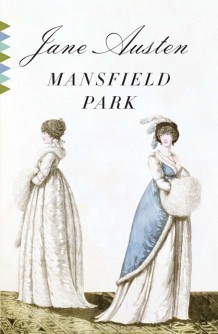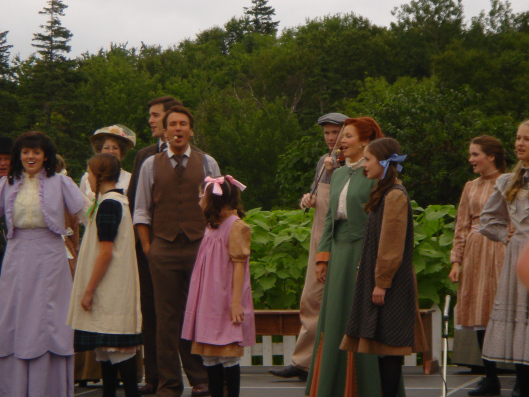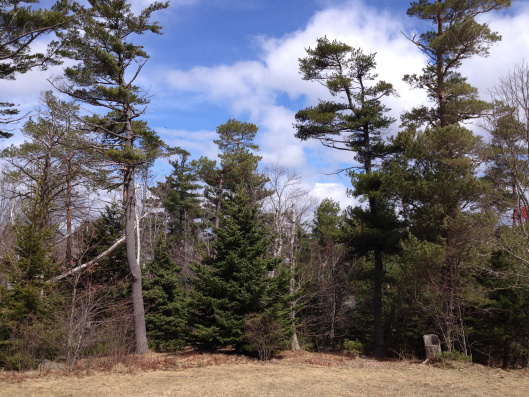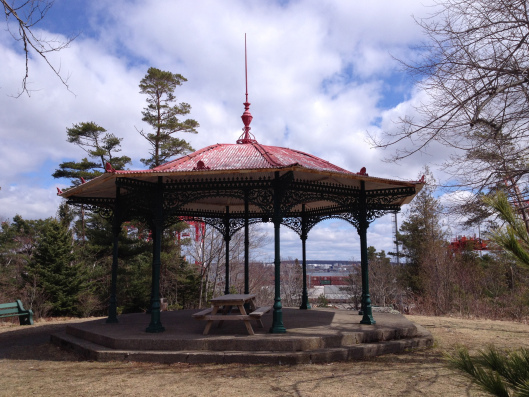Sarah Emsley's Blog, page 35
May 2, 2014
“I have something in hand…” ~ The Publishing of Jane Austen’s Mansfield Park
Jane Austen’s Mansfield Park was published two hundred years ago this month, on May 9, 1814. To begin the celebrations, here’s a wonderful, and beautifully illustrated, account of the publication history of the novel by Deborah Barnum of Jane Austen in Vermont. Thanks, Deb!
Please join us for more Mansfield Park posts this month and throughout 2014. Next Friday, Lyn Bennett will discuss the opening paragraph of the novel.
 Originally posted on Jane Austen in Vermont:
Originally posted on Jane Austen in Vermont:
I have something in hand – which I hope on the credit of P. & P. will sell well, tho’ not half so entertaining.(Ltr. 86: 3 – 6 July 1813, to Capt. Francis Austen)
*****************
Dear Gentle Readers: This history of the publishing of Mansfield Park serves as an introduction to Sarah Emsley’s series “An Invitation to Mansfield Park,” which will begin on May 9th on her blog. As we celebrate this bicentenary of Austen’s third novel, published in May 1814, it seems only right to begin at the beginning, from when Austen first makes mention of Mansfield Park in her letters and its subsequent road to publication, to the later printings and early illustrated works. I am posting it here because of its length and number of illustrations – and Sarah will be re-blogging it immediately. Please continue to visit her blog for the interesting posts she…
View original 4,244 more words


April 25, 2014
A “blinding flash of illumination”
Third in a series of three posts on “Anne of Green Gables in Point Pleasant Park.” Here’s Part One, “Anne of Green Gables Loves Point Pleasant Park,” and here’s Part Two, “Gilbert Would Never Compose a Sonnet to My Eyes.”
In Anne of the Island, Roy Gardner writes sonnets about Anne Shirley, but Gilbert Blythe laughs when she tells him something funny and Roy doesn’t. Anne wonders “uneasily if life with a man who had no sense of humor might not be somewhat uninteresting in the long run.” I like how the syntax of that line reflects her convoluted thinking. Life with a man who can’t laugh might be dull. The phrasing “might not be somewhat uninteresting in the long run” is lovely in its awkwardness. She’s still trying to persuade herself that Roy is the right man: “who could expect a melancholy, inscrutable hero to see the humorous side of things? It would be flatly unreasonable.”
She’s still trying when Roy proposes. Where does he propose? In the park, of course: “Roy asked Anne to marry him in the little pavilion on the harbor shore where they had talked on the rainy day of their first meeting. Anne thought it very romantic that he should have chosen that spot.”
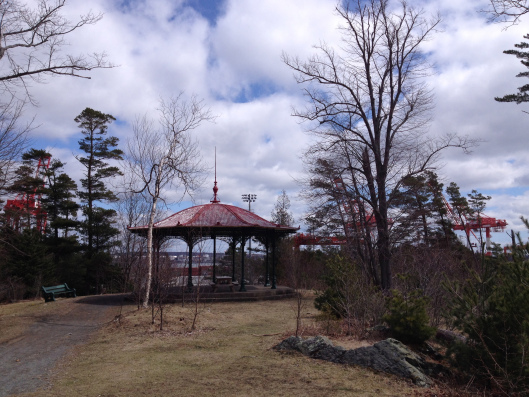
One of the two pavilions in Point Pleasant Park
Readers who know what Montgomery thought of Halifax (“the grimiest city in Canada”) know better than to think any proposal in any setting in this town could be acceptable to her Island heroine (even if Anne was born in Nova Scotia and is technically a “Come-from-Away” on the Island). Montgomery doesn’t tell us exactly what Roy says, but “it was as beautifully worded as if he had copied it, as one of Ruby Gillis’ lovers had done, out of a Deportment of Courtship and Marriage.” Anne recognizes that her response is not what it should be: she “felt that she ought to be thrilling from head to foot. But she wasn’t; she was horribly cool.”
She prepares to say “her fateful yes,” but she can’t do it. A “blinding flash of illumination” shows her that she can’t (readers of Jane Austen’s Emma might say “it darted through her, with the speed of an arrow”). And Montgomery does give us her words: “Oh, I can’t marry you – I can’t – I can’t” (readers of Austen’s Mansfield Park might think of Fanny Price – or of King Lear – “no, no, no”; “never, never, never”).
When Roy leaves, having told her she has ruined his life, Anne sits “for a long time in the pavilion, watching a white mist creeping subtly and remorselessly landward up the harbor. It was her hour of humiliation and self-contempt and shame. Their waves went over her. And yet, underneath it all, was a queer sense of recovered freedom.” There’s no mention of those beloved pines in this passage; presumably Anne doesn’t need comfort from the trees, because despite her feeling of shame, and disappointment in herself, she isn’t sorrowful. Maybe that white mist represents the fog that has concealed her true feelings about Roy.
At the very end of the novel, Gilbert proposes a second time (rather like Mr. Darcy proposing to Elizabeth Bennet for the second time at the end of Pride and Prejudice – and yes, I do link almost everything I read back to Jane Austen in some way, but I’m not imagining the connection between Anne and Gilbert and Elizabeth and Darcy. See Miriam Rheingold Fuller’s essay “Jane of Green Gables: L.M. Montgomery’s Reworking of Austen’s Legacy”). Significantly, he and Anne aren’t in Kingsport/Halifax anymore, but back at home in Avonlea. There’s no romantic rain, no pretty pavilion, no white mist. They walk through the woods together to visit a garden (Hester Gray’s garden, a hidden, neglected place that Anne and Diana Barry and their friends discovered long ago, in Anne of Avonlea, the garden of a young woman from Boston who died only a few years after she married).
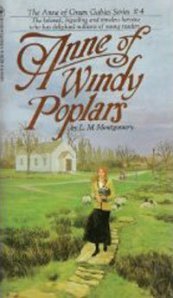 In this proposal, we do get to hear Gilbert’s words. He asks if Anne has “any unfulfilled dreams,” and, after listening to her reply about unfulfilled dreams in general – “It wouldn’t do for us to have all our dreams fulfilled” – he tells her of his very specific dream: “I persist in dreaming it, although it has often seemed to me that it could never come true. I dream of a home with a hearth-fire in it, a cat and a dog, the footsteps of friends – and you!”
In this proposal, we do get to hear Gilbert’s words. He asks if Anne has “any unfulfilled dreams,” and, after listening to her reply about unfulfilled dreams in general – “It wouldn’t do for us to have all our dreams fulfilled” – he tells her of his very specific dream: “I persist in dreaming it, although it has often seemed to me that it could never come true. I dream of a home with a hearth-fire in it, a cat and a dog, the footsteps of friends – and you!”
This time, it isn’t humiliation, self-contempt, or shame, but “happiness” that “was breaking over [Anne] like a wave. It almost frightened her.” Gilbert continues, “I asked you a question over two years ago, Anne. If I ask it again will you give me a different answer?” What does she say? Nothing – she answers him by looking at him with love, and then they talk over the misunderstandings of the past, and begin to make plans for their future together.
And what is immediately ahead of them? He tells Anne he has to ask her to wait a long time while he completes his medical training, and she says the waiting doesn’t matter. “We’ll just be happy, waiting and working for each other – and dreaming.”
Gilbert is headed back to Kingsport/Halifax and the medical school there – a.k.a. Dalhousie Medical School….
Previous posts on L.M. Montgomery and Halifax:
Point Pleasant Park as a Cure for Homesickness
Anne of Green Gables in Kingsport/Halifax
Anne of Green Gables Loves Point Pleasant Park
“Gilbert Would Never Compose a Sonnet to My Eyes”


April 24, 2014
“Gilbert Would Never Compose a Sonnet to My Eyes”
Second in a series of three posts on “Anne of Green Gables in Point Pleasant Park.” Read Part One here. Watch for Part Three tomorrow.
Anne Shirley and her friends do find the perfect house to live in while studying at Redmond College (Dalhousie University) in Kingsport (Halifax): Patty’s Place, a small house near the park, on a street that boasts many houses much larger and much grander. (You can read more about Patty’s Place and “Spofford Avenue,” inspired by Young Avenue, in “L.M. Montgomery’s Halifax: The Real Life Inspiration for Anne of the Island,” by Sue Lange, in The Shining Scroll, the newsletter for the L.M. Montgomery Literary Society.)
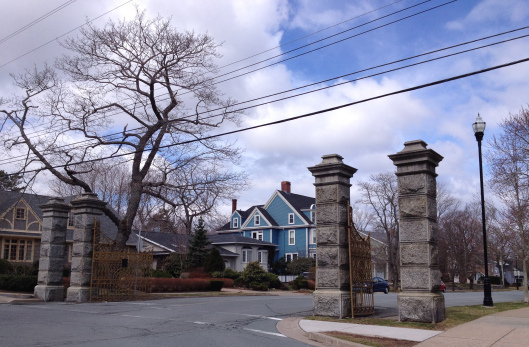
Young Avenue
Gilbert Blythe proposes, Anne rejects him, and not long after that, she meets Royal Gardner for the first time on “a gray day in the windy park.” Her umbrella has blown inside out and he offers his. “Tall and handsome and distinguished-looking – dark, melancholy, inscrutable eyes – melting, musical, sympathetic voice – yes, the very hero of her dreams stood before her in the flesh. He could not have more closely resembled her ideal if he had been made to order.” He suggests that they wait out the rain under the shelter of the pavilion, which gives them nearly an hour of conversation, and before long Anne begins to think he might really be the hero she’s dreamt of.
It isn’t surprising that Anne spends more time in the park than in Old St. John’s cemetery, given that she loves trees so much. On one of her visits with her friends, “The girls wandered down a long pineland aisle that seemed to lead right out into the heart of a deep-red, overflowing winter sunset.” Philippa finds the walk so inspiring, she wishes she knew how to write a poem. “It’s all so wonderful here – ” she says, “this great, white stillness, and those dark trees that always seem to be thinking.”
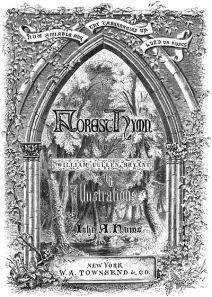 Instead of writing a poem, Anne quotes – well, misquotes – the first line of William Cullen Bryant’s 1824 poem “A Forest Hymn” in reply: “‘The woods were God’s first temples,’” adding “One can’t help feeling reverent and adoring in such a place. I always feel so near Him when I walk among the pines.” (The first line of the poem is “The groves were God’s first temples.”) On this walk, Philippa tells Anne about her engagement, and her question about whether Anne is going to marry Roy Gardner prompts Anne to think carefully about both Roy and Gilbert. Roy, who wrote a poem for her on her birthday – “very good stuff of its kind”; “very tolerable magazine verse” about eyes like stars and lips “redder than the roses of Paradise” – and Gilbert, who “would never have dreamed of writing a sonnet to her eyebrows.”
Instead of writing a poem, Anne quotes – well, misquotes – the first line of William Cullen Bryant’s 1824 poem “A Forest Hymn” in reply: “‘The woods were God’s first temples,’” adding “One can’t help feeling reverent and adoring in such a place. I always feel so near Him when I walk among the pines.” (The first line of the poem is “The groves were God’s first temples.”) On this walk, Philippa tells Anne about her engagement, and her question about whether Anne is going to marry Roy Gardner prompts Anne to think carefully about both Roy and Gilbert. Roy, who wrote a poem for her on her birthday – “very good stuff of its kind”; “very tolerable magazine verse” about eyes like stars and lips “redder than the roses of Paradise” – and Gilbert, who “would never have dreamed of writing a sonnet to her eyebrows.”
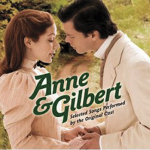 At this point in rereading Anne of the Island, I got one of the songs from “Anne and Gilbert: The Musical” stuck in my head: “Gilbert Would Never Compose a Sonnet to My Eyes.” You can listen to part of the song here. The musical is wonderful, and if you happen to be in Charlottetown this summer, you should definitely go to this one (as well as to the more famous, long-running “Anne of Green Gables: The Musical” at the Confederation Centre for the Arts). Even if you aren’t in PEI this summer, you can buy the songs or the whole album (and no, no one’s paying me to promote any of this!).
At this point in rereading Anne of the Island, I got one of the songs from “Anne and Gilbert: The Musical” stuck in my head: “Gilbert Would Never Compose a Sonnet to My Eyes.” You can listen to part of the song here. The musical is wonderful, and if you happen to be in Charlottetown this summer, you should definitely go to this one (as well as to the more famous, long-running “Anne of Green Gables: The Musical” at the Confederation Centre for the Arts). Even if you aren’t in PEI this summer, you can buy the songs or the whole album (and no, no one’s paying me to promote any of this!).
I especially recommend “Gilbert Loves Anne of Green Gables” and “You’re Island Through and Through” (“If you mind your business and you mind your neighbour’s, too, you’re Island, you’re Island through and through”). And I love the line from Gilbert’s “Saturday Morning” about “marking papers” – the tone in which he says that line takes me right back to my long days, and nights, of marking essays. I saw “Anne and Gilbert” in Summerside during the summer of 2011 and I’d love to see it again. Here’s a photo of the cast performing “You’re Island Through and Through” – on a temporary stage in front of Green Gables itself.
Stay tuned for tomorrow’s post, Part Three of “Anne of Green Gables in Point Pleasant Park.”
Previous posts on L.M. Montgomery and Halifax:
“Point Pleasant Park as a Cure for Homesickness”
“Anne of Green Gables in Kingsport/Halifax”
“Anne of Green Gables Loves Point Pleasant Park”


April 23, 2014
Anne of Green Gables Loves Point Pleasant Park
Early in Anne of the Island, Anne Shirley and Gilbert Blythe go for a walk in Point Pleasant Park with a few friends. L.M. Montgomery doesn’t call the park “Point Pleasant,” but neither does she give it a new name, in the way that she fictionalizes Halifax as Kingsport and Dalhousie University as Redmond College. It’s simply “the park,” recognizable as Point Pleasant because of its shore road and its view of the small, treeless island in the harbour – George’s Island, here named “William’s Island.”
“Gilbert and Anne loitered a little behind the others, enjoying the calm, still beauty of the autumn afternoon under the pines of the park, on the road that climbed and twisted around the harbour shore.” The two of them are good friends at this point, but Gilbert is beginning to indicate he’d like to be more than friends. Montgomery herself sought solace in this park when she was unhappy, and Anne similarly claims, “if ever any great sorrow came to me, I would come to the pines for comfort.” Gilbert replies, “If I had my way I’d shut everything out of your life but happiness and pleasure, Anne” – and he says this “in the tone that meant ‘danger ahead.’”
Anne cuts the conversation short and they rejoin the others in a “little pavilion,” from which they “watch an autumn sunset of deep red fire and pallid gold.” Here’s a picture of one of the old pavilions in Point Pleasant, from which the view is similar to what Montgomery describes in the novel – although I think it would be hard to see the sentry Anne’s friend Philippa spots on the island, standing “on the summit of the fort, right beside the flag.”
She thinks he looks “as if he had stepped out of a romance.” But of course, in fiction Montgomery can put the pavilion wherever she wants to, and make the island closer to the park.
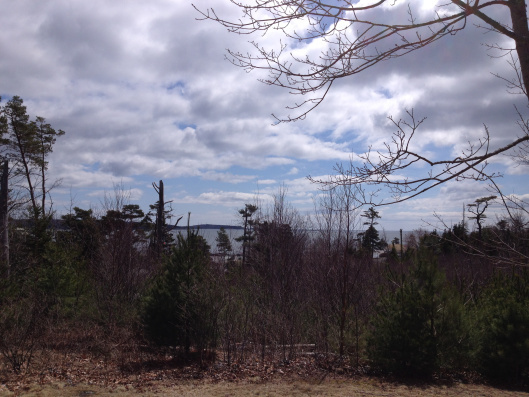
Looking towards the mouth of the harbour from the pavilion
To their left lay Kingsport, its roofs and spires dim in their shroud of violet smoke. To their right lay the harbor, taking on tints of rose and copper as it stretched out to the sunset. Before them the water shimmered, satin smooth and silver gray, and beyond, clean shaven William’s Island loomed out of the mist, guarding the town like a sturdy bulldog. Its lighthouse beacon flared through the mist like a baleful star, and was answered by another in the far horizon.
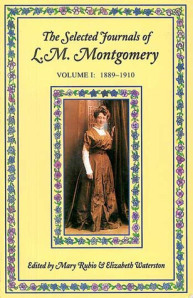 Later in the novel, when Anne and her friends are looking for a house to rent, they visit the park again “on one of April’s darling days of breeze and blue,” with Anne insisting she won’t worry about finding the right place “just now,” because worry will “spoil this lovely afternoon.” The narrator uses almost exactly the same words Montgomery used in her journal when she described her March 15, 1902 walk in Point Pleasant: “The fresh chill air was faintly charged with the aroma of pine balsam, and the sky above was crystal clear and blue – a great inverted cup of blessing.” Here’s what she says in the journal: “The fresh, chill spring air was faintly charged with the aroma of pine balsam and the sky over me was clear and blue – a great inverted cup of blessing.”
Later in the novel, when Anne and her friends are looking for a house to rent, they visit the park again “on one of April’s darling days of breeze and blue,” with Anne insisting she won’t worry about finding the right place “just now,” because worry will “spoil this lovely afternoon.” The narrator uses almost exactly the same words Montgomery used in her journal when she described her March 15, 1902 walk in Point Pleasant: “The fresh chill air was faintly charged with the aroma of pine balsam, and the sky above was crystal clear and blue – a great inverted cup of blessing.” Here’s what she says in the journal: “The fresh, chill spring air was faintly charged with the aroma of pine balsam and the sky over me was clear and blue – a great inverted cup of blessing.”
The 1985 edition of The Selected Journals of L.M. Montgomery, Volume I: 1889-1910, edited by Mary Rubio and Elizabeth Waterston, didn’t include that lovely March 15th journal entry about Point Pleasant, which is part of why it’s so great that Rubio and Waterston are now editing The Complete Journals of L.M. Montgomery. If I hadn’t read the second volume of The Complete Journals – The PEI Years, 1901-1911, I wouldn’t have seen the connection between the novel and the journal. Rubio and Waterston don’t footnote the examples of Montgomery drawing on her journals in her fiction, likely because it happens so often. I’d be interested to read more about this topic, so if any of you have suggestions for books or essays on links between the journals and the novels – or on the role of Halifax in Montgomery’s fiction – please send them my way.
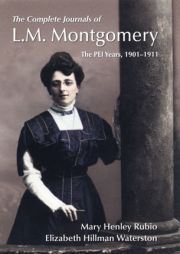 You can read my review of The Complete Journals – The PEI Years, 1901-1911 in the Fall 2013 issue of Atlantic Books Today on page 33.
You can read my review of The Complete Journals – The PEI Years, 1901-1911 in the Fall 2013 issue of Atlantic Books Today on page 33.
This is Part One of three posts on “Anne of Green Gables in Point Pleasant Park.” I’ll post Part Two, “Gilbert Would Never Compose a Sonnet to My Eyes,” tomorrow and Part Three, “A ‘blinding flash of illumination’” on Friday.
Previous posts on L.M. Montgomery and Halifax:
“Point Pleasant Park as a Cure for Homesickness”
“Anne of Green Gables in Kingsport/Halifax”


April 17, 2014
Celebrate 200 Years of Mansfield Park with JASNA Nova Scotia
The next JASNA Nova Scotia meeting is on Sunday, May 4th at 2pm. We’re venturing outside the Halifax area – hooray! – and we’re meeting at Catherine Morley’s house in the beautiful town of Hantsport. Let me know (by leaving a comment below) if you’re interested in attending and need directions.

Blue Beach, near Hantsport, NS
I’ll be speaking on one of my favourite topics: “Why Mansfield Park is a Tragedy,” and leading a discussion of the novel, especially its famous “Let other pens dwell on guilt and misery” ending. You can read about why I think it’s a tragedy in this post I wrote a couple of months ago.
And then on May 9th, you can read Lyn Bennett’s guest post on the opening paragraph of Mansfield Park on the blog. If you haven’t received it yet, you can find “Your Invitation to Mansfield Park” here.
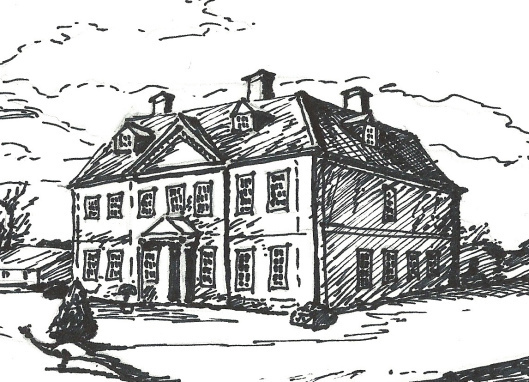
An Invitation to Mansfield Park
I love this novel and I’m excited about discussing it with JASNA NS in person and with all of you on-line. Next week, I’ll write more about Anne of Green Gables and Halifax, and then it’s on to the Mansfield Park celebrations!


April 15, 2014
A Visit to Henry James’s House
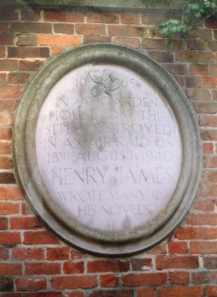
The wall around the garden at Lamb House. “In a garden house on this site – destroyed in an air raid on 18th August 1940 Henry James wrote many of his novels”
Henry James was born 171 years ago today, on April 15, 1843, and in honour of the occasion, I’d like to share with you an essay my dear friend Michèle Mendelssohn wrote about her first visit to James’s house in Rye, East Sussex.
Though I had seen pictures of Lamb House, they hadn’t adequately prepared me for the reality. Or rather: they had given me another reality to superimpose upon my experience. Wedged into a dark corner of West Street, the house glowered at me as I approached. The high stone wall that girdled the garden made the place seem carceral….
Click here to read the essay in The New Compass, the journal Michael DiSanto and I co-founded and co-edited several years ago. For more information about Michèle and her work on James and Oscar Wilde, including her book Henry James, Oscar Wilde and Aesthetic Culture (2007), you can visit the Mansfield College website.
For many years, Michèle and I have compared notes about our research and writing, and she gave me some very helpful advice when I was working on my critical edition of Edith Wharton’s novel The Custom of the Country. I can’t wait to read the new book she’s writing, on Oscar Wilde’s 1882 lecture tour in North America – how can you resist a book titled Going ‘Wilde’? (Plus, Wilde visited Halifax, and I love reading about Nova Scotia’s literary history.)
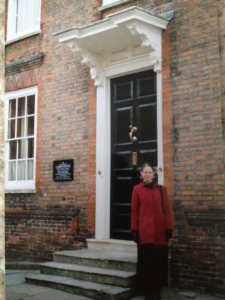
My cousin Honor Lewington took this picture of me at Lamb House, on one of our many “motor-flights” to literary sites in England (inspired by Edith Wharton’s book A Motor-Flight Through France).
I went to Rye once, but my visit was disappointing because Lamb House was closed. I did get to see the house glowering at me, though. Michèle has no photos from her pilgrimage, and she made me promise to include one from my own. I’ve had better luck with visits to The Mount, Edith Wharton’s house in Lenox, Massachusetts, and Jane Austen’s House Museum in Hampshire.
Joy Sussman took some beautiful photographs at The Mount on her visit there a few weeks ago – see her blog post on “Simple Pleasures: All By Myself at Edith Wharton’s House.” You can tour Jane Austen’s House Museum in this entertaining blog post by Karen Doornebos at Jane Austen in Vermont.
Still, I understand the point Michèle makes about “the inevitable discrepancy between our expectations (tempered by our readings) and the real thing.” I wrote a little bit about this idea in my post on “L.M. Montgomery’s Literary Pilgrimage to Concord, Mass.” – do we really think we’ll understand the works better because we’ve seen where they were written? What are we looking for when we visit authors’ houses, and why? 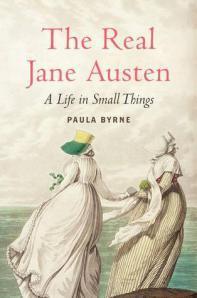
Paula Byrne writes in her uconventional biography The Real Jane Austen (2013) that “Both [Austen’s] world and her novels can be brought alive through the textures of things, the life of objects.” Perhaps in visiting the houses Austen, James, Wharton, and Montgomery lived in, we may catch at least a glimpse of the worlds that inspired their writing, even though, as Michèle writes, we “must reconcile ourselves to the fact that the author’s house will never be a home, no matter how well we think we know it.”
What literary pilgrimages have you made, and what was your experience like?


April 9, 2014
Your Invitation to Mansfield Park
 You’re invited to a conversation about Jane Austen’s Mansfield Park!
You’re invited to a conversation about Jane Austen’s Mansfield Park!
When: from May 9 to December 31, 2014
Where: right here at sarahemsley.com
I really hope you’ll join us in celebrating 200 years of Austen’s masterpiece. More than forty wonderful people are writing guest posts about Mansfield Park for my blog this year, and I hope you’ll all participate in the discussion in the comments. With exactly one month to go before the 200th anniversary of the novel’s publication, the countdown is on!
The party begins on Friday, May 9th, with Lyn Bennett’s thoughts on the first paragraph, followed in the next few weeks by Judith Thompson on Mrs. Norris and adoption, Jennie Duke on Fanny Price at age ten (“though there might not be much in her first appearance to captivate, there was, at least, nothing to disgust her relations”), Cheryl Kinney on Tom Bertram’s assessment of Dr. Grant’s health (“he was a short–necked, apoplectic sort of fellow, and, plied well with good things, would soon pop off”), and Katie Davis on Mrs. Grant’s promise to Mary and Henry Crawford that “Mansfield shall cure you both.” Many other excellent guest posts will follow throughout the summer and fall. Plus, one week before the series begins, Deborah Barnum of Jane Austen in Vermont is going to tell us all about the publication history of Mansfield Park. 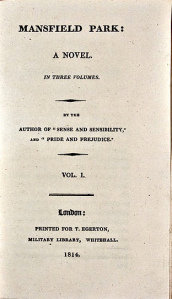
Please share this invitation with anyone who might want to participate in the conversations about, and celebration of, this brilliant novel. For the full list of contributors to the series, visit my new page “An Invitation to Mansfield Park,” which also includes links to several other blog posts and articles on the novel. Please let me know if you have suggestions for resources to add to this list. What have you been reading recently about Mansfield Park?
You can also visit my Pinterest board for Mansfield Park, and I’d love to hear from you about book covers and other MP-related images to add to the collection.
Many thanks to Laurel Ann Nattress of Austenprose.com, who gave me the elegant title “An Invitation to Mansfield Park” (thereby saving me from becoming Miss Bates), and thank you to everyone who contributed suggestions about the title. Thank you to Maggie Arnold for the lovely sketches of Mansfield Park and of Fanny Price reading. Thank you to everyone who’s writing for the series, and, of course, a huge thank you to all of you who are reading with us! Let me know if you’re coming to this party.


April 2, 2014
Anne of Green Gables and the Old Burying Ground, Halifax
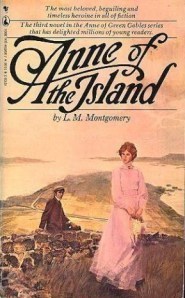 When Anne Shirley first arrives in Kingsport (Halifax), in L.M. Montgomery’s Anne of the Island, she’s told that her room looks out on “Old St. John’s Graveyard,” across the street from her boarding house. She says the view sounds “gruesome,” but her friend Priscilla makes the case for the graveyard as a romantic spot. Much has changed in Halifax in the century since L.M. Montgomery was a student at Dalhousie, but the Old Burying Ground has changed very little (thanks to the efforts of the Old Burying Ground Foundation). Here’s Priscilla’s description, at the end of Chapter Three:
When Anne Shirley first arrives in Kingsport (Halifax), in L.M. Montgomery’s Anne of the Island, she’s told that her room looks out on “Old St. John’s Graveyard,” across the street from her boarding house. She says the view sounds “gruesome,” but her friend Priscilla makes the case for the graveyard as a romantic spot. Much has changed in Halifax in the century since L.M. Montgomery was a student at Dalhousie, but the Old Burying Ground has changed very little (thanks to the efforts of the Old Burying Ground Foundation). Here’s Priscilla’s description, at the end of Chapter Three:
Old St. John’s is a darling place. It’s been a graveyard so long that it’s ceased to be one and has become one of the sights of Kingsport. I was all through it yesterday for a pleasure exertion. There’s a big stone wall and a row of enormous trees all around it, and rows of trees all through it, and the queerest old tombstones, with the queerest and quaintest inscriptions. You’ll go there to study, Anne, see if you don’t. Of course, nobody is ever buried there now. But a few years ago they put up a beautiful monument to the memory of Nova Scotian soldiers who fell in the Crimean War. It is just opposite the entrance gates and there’s ‘scope for imagination’ in it, as you used to say.
Later that evening in her room, Anne looks out to the quiet street: “Across it the moon was shining above the trees in Old St. John’s, and just behind the great dark head of the lion on the monument.” The narrator tells us that “Every citizen of Kingsport feels a thrill of possessive pride in Old St. John’s, for, if he be of any pretensions at all, he has an ancestor buried there, with a queer, crooked slab at his head, or else sprawling protectively over the grave, on which all the main facts of his history are recorded.”
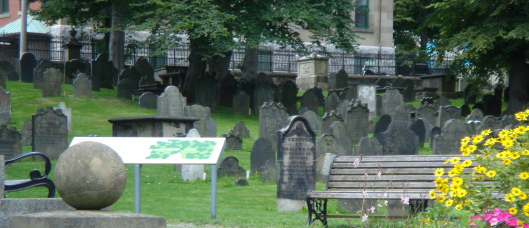
The Old Burying Ground
Anne and Priscilla explore the cemetery, taking turns reading inscriptions on the tombstones. Just as Montgomery found comfort in her walks through Halifax’s Point Pleasant Park when she was homesick for Prince Edward Island, Anne finds comfort when she communes with nature in Old St. John’s: “I don’t know that a graveyard is a very good place to go to get cheered up, but it seems the only get-at-able place where there are trees, and trees I must have. I’ll sit on one of those old slabs and shut my eyes and imagine I’m in the Avonlea woods.”
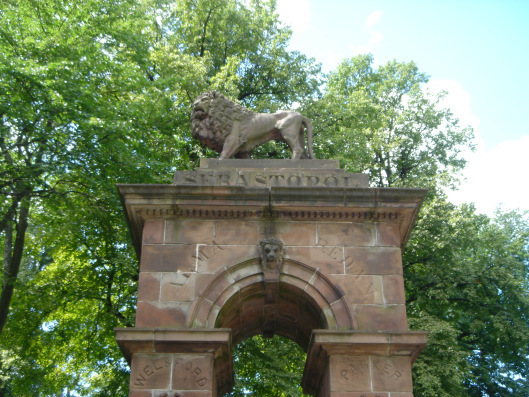
The Welsford-Parker Monument. I decided to dig out some old photos taken in summer, instead of taking more pictures of Halifax in the snow. Yes, it is STILL snowing here…. No signs of spring.
The Welsford-Parker Monument was erected in 1860 as a memorial to Major Augustus Welsford of the 97th Regiment and Captain William Parker of the 77th Regiment, who died at Sebastopol on September 8, 1855. The arch and lion were carved from New Brunswick sandstone by George Laing.
Major-General Robert Ross, who commanded the British troops who set fire to Washington and the president’s mansion in 1814, is buried in the cemetery. Captain James Lawrence of the defeated U.S.S. Chesapeake died in the battle with H.M.S. Shannon in 1813 and was buried here, but was later reburied in Trinity Churchyard, New York. Anne imagines the day the Shannon sailed into “Kingsport Harbor”:
The old graveyard, with its overarching trees and long aisles of shadows, faded from her sight. Instead, she saw the Kingsport Harbor of nearly a century agone. Out of the mist came slowly a great frigate, brilliant with ‘the meteor flag of England.’ Behind her was another, with a still, heroic form, wrapped in his own starry flag, lying on the quarter deck – the gallant Lawrence. Time’s finger had turned back his pages, and that was the Shannon sailing triumphant up the bay with the Chesapeake as her prize.
‘I’ve always loved that old story,’ [Anne] said, ‘and although the English won that victory, I think it was because of the brave, defeated commander I love it.’
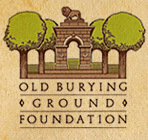 The graveyard closed in 1844, and it was not until the 1980s that restoration work began. A second major restoration has been underway in recent years, and the Old Burying Ground Foundation is grateful for any donations.
The graveyard closed in 1844, and it was not until the 1980s that restoration work began. A second major restoration has been underway in recent years, and the Old Burying Ground Foundation is grateful for any donations.
You can also read more about the Old Burying Ground in “L.M. Montgomery’s Halifax: The Real Life Inspiration for Anne of the Island,” by Sue Lange, in The Shining Scroll, the newsletter for the L.M. Montgomery Literary Society.
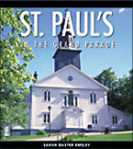 And you can read more about both the Old Burying Ground and St. Paul’s Church in my book St. Paul’s in the Grand Parade.
And you can read more about both the Old Burying Ground and St. Paul’s Church in my book St. Paul’s in the Grand Parade.
If you missed last week’s post on “Anne of Green Gables in Kingsport/Halifax,” you can find it here.


March 27, 2014
Anne of Green Gables in Kingsport/Halifax
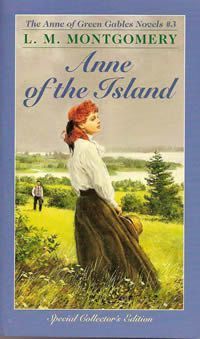 When I read Anne of the Island, the third of L.M. Montgomery’s “Anne” books, as a child, I was living in Halifax. I remember being aware that Montgomery based “Redmond College” on Dalhousie University, and “Kingsport” on Halifax, but I was absorbed in the story and didn’t pay much attention to the landmarks described in the novel. I’ve learned a lot more about Halifax history since then, and I’ve spent a lot of time at Dalhousie, so when I reread the book recently, I found I was even more interested in the setting than in its heroine.
When I read Anne of the Island, the third of L.M. Montgomery’s “Anne” books, as a child, I was living in Halifax. I remember being aware that Montgomery based “Redmond College” on Dalhousie University, and “Kingsport” on Halifax, but I was absorbed in the story and didn’t pay much attention to the landmarks described in the novel. I’ve learned a lot more about Halifax history since then, and I’ve spent a lot of time at Dalhousie, so when I reread the book recently, I found I was even more interested in the setting than in its heroine.
In Chapter Four, when Anne is just beginning to get to know Kingsport, Montgomery gives a snapshot of the town:
Kingsport is a quaint old town, hearking back to early Colonial days, and wrapped in its ancient atmosphere, as some fine old dame in garments fashioned like those of her youth. Here and there it sprouts out into modernity, but at heart it is still unspoiled; it is full of curious relics, and haloed by the romance of many legends of the past.
It has in its park a martello tower, autographed all over by tourists, a dismantled old French fort on the hills beyond the town, and several antiquated cannon in its public squares. It has other historic spots also, which may be hunted out by the curious, and none is more quaint and delightful than Old St. John’s Cemetery at the very core of the town, with streets of quiet, old-time houses on two sides, and busy, bustling, modern thoroughfares on the others.
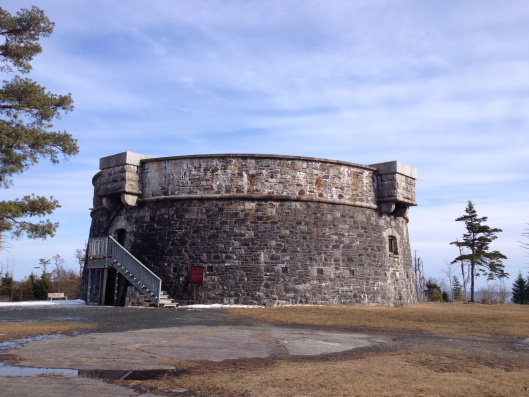
The Prince of Wales Martello Tower in Point Pleasant Park, built in 1796-97 under the direction of Prince Edward, Duke of Kent.
Montgomery lived in Halifax and took classes in English literature at Dalhousie in 1895-96, and she boarded in a house on Barrington Street. Barrington, a favourite street of mine because I lived there when I was in graduate school in English at Dalhousie, is fictionalized in Anne of the Island as St. John’s Street. Old St. John’s Cemetery is the Old Burying Ground (the cemetery for St. Paul’s Church), and I’ll write more about it soon.
You can also read more about this topic in “L.M. Montgomery’s Halifax: The Real Life Inspiration for Anne of the Island,” by Sue Lange, and “The Dalhousie Girls,” by Christy Woster,” in The Shining Scroll, the newsletter for the L.M. Montgomery Literary Society. The newsletter reproduces some lovely old postcards with views of places in Halifax, including Young Avenue, Point Pleasant Park, the Old Burying Ground, and St. Paul’s Church.
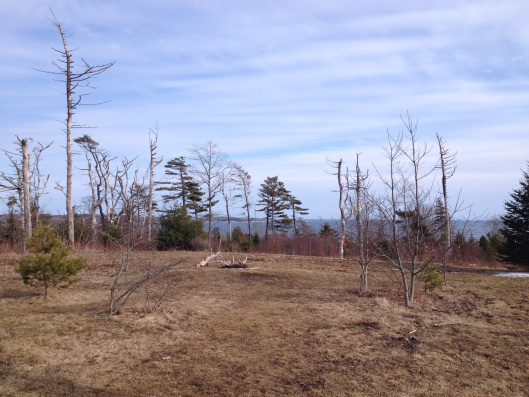
Looking out to sea from the Martello Tower. I took these pictures last Sunday; the park is now covered in snow once again, because of the major storm that started yesterday. Springtime in Nova Scotia!


March 18, 2014
“Reliving the Regency Ball”
You’re invited to an evening at Government House in Halifax on Tuesday, April 1st, to hear Carole and Anne Thompson and members of the Nova Scotia Region of the Jane Austen Society of North America talk about “The Enduring Fascination with Jane Austen and her World.” Their focus is on the customs of a Regency Ball, two hundred years after Austen’s time, and the talk will take place at 7pm in the elegant ballroom at Government House, 1451 Barrington Street in Halifax.
Registration opens today! Call 902-424-7001 or send an email to lgoffice@gov.ns.ca to book your spot at this free, public event.
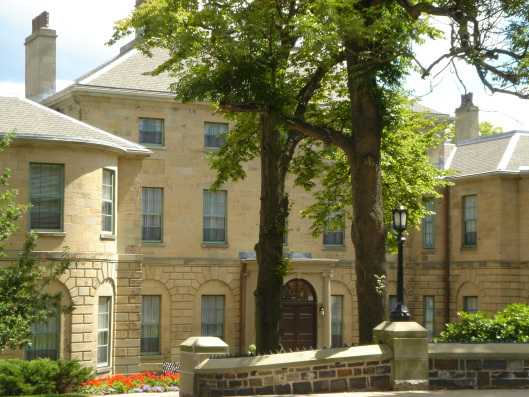
Government House
For more information about this talk and other events in the “Evenings @ Government House” series, click here.
His Honour, Lt.-Gov. J.J. Grant and Her Honour Mrs. Joan Grant invite Nova Scotians, particularly those that have never visited Government House before, to attend a new public event series designed to showcase civic and cultural excellence in Nova Scotia.
This exciting initiative entitled “Evenings @ Government House” will feature diverse presenters and performers from a range of communities across Nova Scotia including musicians, authors, scientists, sporting figures and more. Most events will run from 7:00pm-8:30pm, are free of charge and open to the public.




